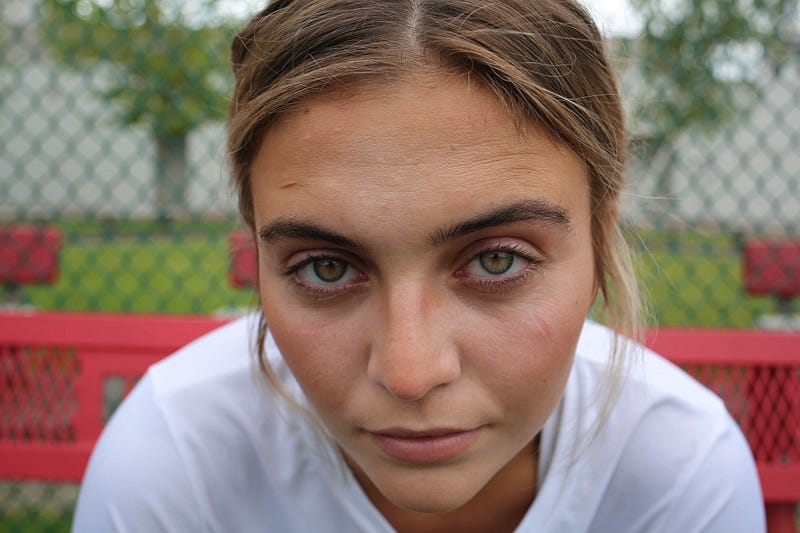Dueling with Disease
Bellingham teen battles mysterious illness for nearly a decade
By Eric Trent

A black and blue tennis racket springs forward, an extension of Britney Butcher’s forearm, as she smacks an opponent’s 70 mph volley and blasts it across the net to the far corner of the court.
Britney lightly taps rackets with her №1 doubles partner, Louli Ziels, as the two celebrate the point and exchange subtle grins. Two grueling hours later the Bellingham High School duo are crowned the 2A North Sub-District champions.
Perhaps only two spectators — Britney’s parents Garth and Tanys Butcher — out of the dozens in attendance, are aware that this 19-year-old tennis star spent six months in a wheelchair two years ago during a seven-year bout with a mysterious illness.
SYMPTOMS BEGIN
It starts with intense foot pain that comes out of nowhere for 10-year-old Britney, a youth athlete in Bellingham who finds herself crying after soccer games due to the intense pain.
At 13 years old the pain has spread up to her joints, making them stiff and cold, starting with the ankles and moving to the knees and elbows. It’s like having a jammed finger but in every joint. Some mornings she doesn’t have the strength in her fingers to grip a glass of water.
Britney tapes her elbows, wrists, ankles and knees at the age of 14 — head to toe — so her joints are warm enough to play sports.
In February 2014, Britney is taken to Seattle Children’s Hospital where she’s diagnosed with juvenile idiopathic arthritis, the most common form of arthritis for children under 16.
Five years of daily medications begin.

It starts with Prednisone then moves to Methotrexate injections, anti-inflammatories that make her nauseous.
Fourteen-year-old Britney gives herself the injections directly into her stomach and legs, while Tanys injects them into the back of Britney’s arms — only because Britney can’t reach.
Britney Butcher, still 14, sprints down a soccer field in Everett, Washington when suddenly her world starts spinning and she can’t breathe, finally crumpling to the ground gasping for air.
Doctors pump the medication out of her system, and when she’s stabilized she’s put on different medication and sent home in a wheelchair.
“It became very obvious that nobody knew what they were dealing with so they just pushed us out the door,” Tanys said.
REMISSION THEN RELAPSE
After being put on Enbrel injections in August 2015, Britney is feeling well enough to play sports her freshman year — the first bit of reprieve she’s had in nearly five years.
It’s short lived.
Her right leg goes numb, eventually losing total feeling and becomes marred with rug burns as she’s forced to drag it behind her as she walks. Her doctor at the time tells her it’s just a side effect of the medication.
Tanys and Garth ask her to stop playing sports so she can rest and heal. Later that day they find the remnants of a soccer poster that hung in Britney’s room.
“One day I came in and it was just in shreds and ripped up,” Tanys said. “I said, ‘What happened to the soccer poster?’ She goes, ‘Well, I’m never playing that again.’”
Normally an active and athletic teenager, Britney is embarrassed to have her peers see her in this condition, and the illness persists for so long that everyone other than her family and close friends begin to question if she’s actually sick.
“Some of the secretaries [at school] would say, ‘Are you off to go have fun today? Is that why you’re leaving?’” Tanys said. “They thought she was faking it. Doctors started to look at me and not believe [me] because I’d been in so many times. One doctor said, ‘Get up. You can go home. This is for emergencies, not for a person like you.’”
Around Christmas 2017 of her junior year, she is taking Vicodin and other painkillers to cope with the pain, but they aren’t touching any of the torture.
By now she has lost nearly 40 pounds, dropping down to 110 pounds.
“My mom would sleep with me at night because she’s like, ‘I don’t know if you’re going to wake up in the morning,’” Britney said. “It got to the point where no one can figure out what’s wrong with me and I’m going to die not knowing anything. It’s a pretty crazy thing to accept when you’re 17.”
DECODING THE PAIN
Tanys is feeding and dressing Britney daily when she receives a tip from a friend who says the symptoms are similar to Lyme disease.
Tanys Googles the illness and as she clicks the mouse something clicks in her head — the symptoms are eerily synonymous.
She calls a diagnostician who refers the Butcher’s to Dr. Susan L. Marra, a Lyme-literate doctor in Seattle.
At this point Britney has been in a wheelchair and hasn’t walked in six months. Dr. Marra takes one look at the sickly 17-year-old and validates what her and the family already knew: something was seriously wrong.
“She was like, ‘This is the worst I’ve ever seen. I cannot promise a full recovery,’” Britney said.
After a gauntlet of tests, in which 30 vials of blood are taken, the Butchers get the answer they’ve been waiting seven years for: Dr. Marra diagnoses Britney with chronic Lyme disease and Bartenolossis, also known as cat scratch fever. The two forms of bacteria have been invading the lining of her blood vessels for seven years.
“I just remember feeling so free,” Britney said. “A huge weight is off your shoulders. The past hour I was accepting ‘What if I don’t make it home on this ride?’”
Britney finally begins treatment for her true ailment in January 2017.
THE DISEASE
No one knows exactly how Britney contracted it, but as a rambunctious kid who was constantly climbing trees and exploring the nearby woods — one can only guess.
Lyme disease is a bacteria that’s transmitted from a tick bite, parasites that are normally found east of the Rocky Mountains but can also live in the forested areas of Washington.
Britney didn’t develop the tell-tale sign of the disease, a bullseye rash that forms on 70 to 80 percent of those affected, which helped the misdiagnosing.
The Centers for Disease Control and Prevention estimate around 300,000 Americans contract Lyme disease each year. Cases are rare in Washington state with zero to three cases reported each year.
“My mom’s like, ‘If you had a tick, you’d rip it off in five seconds,’” Britney said. “I was just one of those kids.”
THE REBOUND
Britney wastes no time recuperating. One month after starting treatment, she regains feeling in her legs. Her boyfriend at the time lifts her from the bed and places her front of a walker. Britney takes her first steps in seven months.
A year later, Britney is playing sports competitively again for the first time in two years. She isn’t chosen as one of the top-3 tennis players on the team and can’t compete in sub-districts.
“I was pretty butthurt about it,” Britney said. “Not gonna lie. It stuck with me.”
She applied for and was granted an extra year of athletic eligibility through the WIAA under its hardship rule because of her illness.
Now she’s gone from being temporarily disabled to bolting back and forth across a tennis court and delivering powerhouse serves for three-straight hours.


“We laugh when we see people upset because maybe their kid didn’t play good,” Garth said.
“We’re just so thankful that she’s even playing. The success is secondary to us, but certainly not to her.”
Even more remarkable is that Britney, now 5-foot-9 and 140 pounds, is only 50 percent healed with an estimated one to two years of recovery left. Her hunger to compete has fueled her meteoric rise to success with the tennis racket.
“Sometimes that fighter thing isn’t always good for you. She probably did too much, but it was so important to her to be a part of a team,” Garth said. “What we’re most proud of is her perseverance and strength. We’re happy she’s walking around and living a normal life, let alone playing tennis how she is now. If you told us she was going to do that six or eight months ago, we would have been hopeful for her but definitely doubtful.”
80 PILLS A DAY
Dr. Marra still treats Britney, who takes a daily regimen of 80 pills consisting of supplements, vitamins and probiotics.
“My whole life has revolved around a schedule of medications,” Britney said. “It’s hard because I’m a teenager and I want to have fun, but I have to put this first. Always.”
She enrolled at Whatcom Community College in 2018 to finish her high school degree and will walk on June 14 with Bellingham’s 2019 graduating class. She also finished her CNA course and is now a certified nursing assistant.
“Being a nurse is very important to me because of what I’ve been through,” Britney said. “It’s something I always wanted, but once I got sick I needed to do it. I feel the need to help people who are in my situation. I’ve had certain nurses who have made my life a lot harder, and nurses who made me feel so much better about everything. I just want to be able to do that for people.”
Things are starting to look positive for the 19-year-old sub-district champion. Her and teammate Louli Ziels placed second at bi-districts on May 13, losing to the defending state champions.
The runner-up finish punched Britney’s ticket to the 2A girls tennis state championships where she competed on May 24 and 25. For once in her teenage life she battled something other than a disease.
“It feels pretty good,” Britney said.“The past three months have been amazing. It feels crazy to me that I’m playing tennis now. I made it and I’m killing it. All the hard work is finally paying off.”